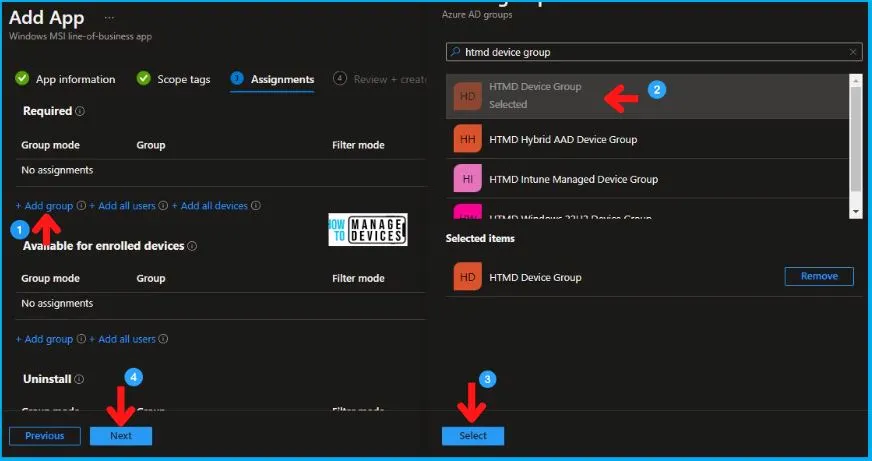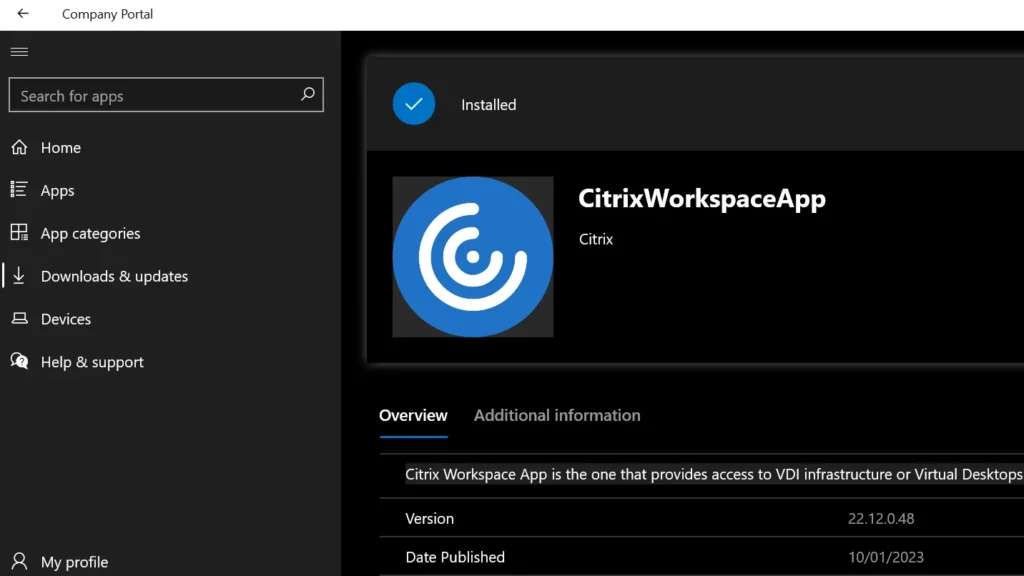Hello Readers! Today, we will learn about Citrix Workspace App Installation using Intune. In this guide, we will make use of the EXE application. We will show you a detailed step-by-step guide for Citrix Deployment using Intune.
Citrix Workspace App is the one that provides access to VDI infrastructure or Virtual Desktops or Virtual Apps. Citrix Virtual Apps and Desktops publish VMs from a hypervisor to remote clients. Every user gets a unique OS and desktop by publishing a virtual machine.
Citrix Workspace app can be used on the domain and non-domain joined PCs, tablets, and thin clients. Citrix also provides ADMX and ADML to deploy the Citrix Workspace App. Logon script and GPO are other options to install and upgrade the Workspace app.
The Citrix Workspace app is the easy-to-install and provides seamless, secure access to everything you need to get work done. Citrix didn’t have any MSI installer for the Citrix Workspace app. The only available installer is an EXE. However, SCCM or Intune can help you to deploy this app on a scale.
You can download the Citrix Workspace App from Citrix. One must download the offline windows setup for 64-bit architecture from the Citrix website. You must use this EXE application guide using Intune for all the other deployments.
- Deploy New Microsoft Store Apps Type From Intune With Winget
- How To Deploy VBScript For Intune Application Installation
Prepare Win32 App Installation Source for Citrix Workspace
Preparing a Win32 app using the Microsoft Win32 Content Prep Tool is necessary before adding it to Microsoft Intune. To pre-process Windows classic (Win32) applications, you use the Microsoft Win32 Content Prep Tool.
Let’s first identify the command line to perform the silent installation or uninstallation of the Citrix Workspace App.
Silent Installation of Citrix Workspace App
With the help of the internet, You can find an Install command for any application. In our case, we have to search the install command for the Citrix Workspace App. After searching, the install command for the Citrix Workspace App is CitrixWorkspaceApp.exe /silent.
After successfully installing Citrix Workspace App using the install command in your test environment, you now have to look for the Uninstall command. Refer to the below table for the details.
| Install Command | Uninstall Command |
|---|---|
| CitrixWorkspaceApp.exe /silent | CitrixWorkspaceApp.exe /uninstall /silent |
Download the updated IntuneWinAppUtil.exe from GitHub. Run IntuneWinAppUtil.exe file Run as administrator.
- Please specify the source folder – Enter the folder that contains your application setup files. (For Example, C:\sources\Citrix)
- Please specify the setup file – Enter the setup file name (such as setup.exe or setup.msi), for example, CitrixWorkspaceApp.exe.
- Specify the output folder – Input the output folder to generate the .intunewin file.
- Do you want to specify catalog folder – Type N.
Note! Please wait a few minutes while running the Win32 Content Prep Tool. Once it generates the .intunewin file, the status indicates 100% at the bottom of the command prompt.

Once the process completes, Browse to the output folder (For Example, C:\sources\Citrix) to collect the Intune Win32 app deployment file.
Citrix Workspace App Installation using Intune
Follow the steps below to upload the Intunewin file for deploying Citrix Workspace App to managed devices. Here’s how you can deploy Citrix Workspace App using Intune Portal.
- Sign in to the Microsoft Intune admin center https://endpoint.microsoft.com/.
- Select Apps > All apps > Add, or navigate to Apps > Windows > Windows Apps.
- On the Select app type pane, select Windows app (Win32) under the Other app types and click Select.

On the Add app pane, click Select app package file. Click the browse button. After that, select the prepared file with the extension .intunewin. Detailed information about the app appears. You can now select OK on the App package file pane when you’re done.

Enter the Name of the Windows App Win32 (For Example, Citrix Workspace App), and Enter the Description of the Windows App. Enter the Publisher name – Citrix, and You may specify the additional app information here.

After entering the above details, you will get the option to Upload an icon for the app by scrolling down on the same page. This icon is displayed with the app when users browse the company portal and click Next.

The most important part is to specify the commands. On the Program, configure the app installation and removal commands for the app:
- Install base: Add the complete installation command line to silent install Citrix. (CitrixWorkspaceApp.exe /silent )
- Uninstall command: Add the uninstallation command line for Citrix. (CitrixWorkspaceApp.exe /uninstall /silent)
- Install behavior: Set the install behavior to System.
You can also specify the Device restart behavior and Post-installation behavior. Click Next to continue.

On the Requirements page, specify the mandatory requirements that devices must meet before installing the update and click Next.
- Operating system architecture: Choose the architectures needed to install Citrix.
- Minimum operating system: Select the minimum operating system needed to install Citrix.
There are some built-in and custom requirements rules when creating your Win32 application. Explore Intune Win32 App Requirement Rules.

On the Detection rules pane, configure the rules to detect the presence of the app. You can choose to add multiple rules. Here I selected the Manually configure detection rules format. Click on Add button, and A popup will appear showing the Detection rule, select File System.
After this, you have to check for the detection method. Here we try to use the File type for the detection method. We must go to a particular file location and select a certain file.
- Select File in the Rule Type, and Select File in the Type box.
- Copy the path in the Path box
- %ProgramFiles(x86)%\Citrix\ICA Client\Receiver or C:\Program Files (x86)\Citrix\ICA Client\Receiver
- Look for the file called “Receiver.exe“
The following table provides clearer options for detecting an exe (CitrixWorkspaceApp.exe) file.
| Setting Type | Path/Hive | File Name/Key |
|---|---|---|
| File System | %ProgramFiles(x86)%\Citrix\ICA Client\Receiver | Receiver.exe |
Check the details from the above table and enter as shown below carefully.

You can also specify app dependencies where the applications must be installed before your Win32 app can be installed. Also, in the scope tag section, you shall get an option to Configure scope tags for this Windows App Win32 application.
Under Assignments, In Included groups, click Add groups and then choose Select groups to include one or more groups to which you want to deploy the Windows Update. Click Next to continue.

Now you will see all the details you provided during the application creation process. Review your settings and select Create to add the app to Intune.

Once you proceed to create, you will see the status Uploading is in progress, If you are thinking about how much time will it take to complete the upload? It depends on the size of the application and the speed of internet connectivity.
Please wait some time to complete the upload process, and you can check the progress by clicking on the Notification icon. Once the intune package is uploaded and finished, you will get the status “Upload finished.”
- Intune Company Portal App for Windows 11 Android | Install and Uninstall
- 32 Privacy Settings for Windows 11 | 99 Intune Privacy Settings Policies
End Users Experience
Intune will deliver targeted applications to your groups when the devices check in with the service that applies to them.
Now login to the device where you targeted the application. The application Citrix Workspace App was successfully installed.

To monitor the application installation from Intune Portal, select the application, and here you can check the device and user check-in status. If you click on Device install status, additional details are displayed.

Track Citrix Workspace Win32 App Deployment
Once the application installation starts, the “Detection rule” will be evaluated. Checks were performed against the rules configured and the app “Install command” will be triggered.
You can track the details logged at IntuneManagementExtension.log located C:\ProgramData\Microsoft\IntuneManagementExtension\Log. You track the application activity in client devices. You can get through an excellent article on Intune Win32 App Issues Troubleshooting for more details.
Where is the folder where Intune downloads the applications before it installs on a Windows device? Intune cache folder location, Below are the 3 Intune Management Extension Agent working folders.
- Incoming
- Staging
- Staged
Let’s learn Intune Win32 App Troubleshooting Client-Side Process Flow. You can look at the Level 3 deep dive troubleshooting Intune Management Extension (IME) Level 3 Troubleshooting Guide.
Author
Abhinav Rana is working as an SCCM Admin. He loves to help the community by sharing his knowledge. He is a B.Tech graduate in Information Technology.

Great post on how to deploy the Citrix Workspace App to Intune devices! What I find the hardest in the deployment of the Citrix Workspace app (with Intune) is the upgrade process:
Depending on how you specify your installation parameters with the Citrix install command- tool, in this example, the auto-upgrade is ‘disabled’ and Citrix Workspace won’t upgrade automatically on the end-users device.
However, as an administrator, you will, and have to, upgrade to a newer version of the application anyhow. When using the same Intune app configuration as described with supersedence (of the old version) enabled, the Citrix Workspace app will be forcedly closed on the end-user device.
In most cases, for end-users with a running session, the upgrade of Citrix Workspace interrupts productivity.
How would you upgrade the Citrix Workspace application within Intune?
Hello Anoop,
As mhilboezen described, is there a way to upgrade the Citrix Workspace app?
Hi Anoop, Deepak,
Any thoughts on the upgrade process without interrupting the end-user?